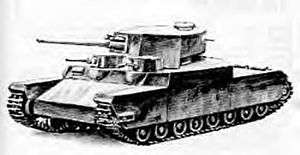O-I
| O-I | |
|---|---|
 | |
| Type | Super-heavy tank |
| Place of origin |
|
| Production history | |
| Designed |
1939–1940 (100 ton O-I), 1943 (120 ton O-I) |
| Produced | 1943 120 ton O-I[1] |
| Number built | 1 prototype |
| Specifications | |
| Weight | 120 tons[1] |
| Length | 10 m[1] |
| Width | 4.2 m[1] |
| Height | 4 m[1] |
| Crew | 11[1] |
|
| |
| Armor | maximum of 200 mm |
Main armament | 105 mm gun with two light rocket artillery canisters |
Secondary armament | Type 1 47 mm tank gun, 3x 7.7 mm Type 97 machine gun[1] |
| Engine |
Two V-12 gasoline engines 550HP |
| Speed | 25 km/h |
O-I was the name given to a proposed series of Japanese super-heavy tanks, to be used in the Pacific Theater. The vehicle was to be very heavy, carrying 11 crew in its 120-ton body. Only one 120 ton O-I prototype was rumored to have been built in 1943. Exact information is lacking.
100 ton design
After the Battles of Khalkhin Gol against the Soviet Union in 1939, Japan tried to improve their tank designs using lessons learned from this battle. Many Japanese tanks such as the Type 95 Ha-Go light tank and the Type 97 Chi-Ha medium tanks were proven to be insufficient to counter Soviet armored forces. A larger tank design was urgently needed. A super heavy tank project was proposed along with new medium tank designs.
In 1940, Hideo Iwakuro, a Colonel from the Army Ministry of Japan (陸軍省 Rikugun-shō) ordered the Army Engineering Division to develop a new super heavy tank. Colonel Iwakuro also indicated that the new tank should be at least two times larger than the current Type 95 Heavy Tank (26 tonnes). The 100 tonne prototype was to be equipped with a 105 mm cannon for its main gun. The frontal hull of the tank was protected by a 75 mm thick armor, and another 75 mm steel plate could be attached to provide additional protection.
120 ton design
Mitsubishi Heavy Industries Tokyo Machinery Division started the development process on the 120 ton version of the "O-I tank" (オイ車, "オ" in Japanese this means "large" and "イ" means "one"). The tank was to be equipped with a 105 mm cannon for its main gun. Its secondary armament consisted of a Type 1 47 mm tank gun and three 7.7 mm machine guns.[1] One of the main features of the O-I tank was its thick armor. Its armor had a maximum thickness of 200 mm,[1] as well as 35 mm +75 mm on its sides and 150 mm at the back.
According to historian Steven Zaloga, there were "rumors that work was underway" on the 120-ton version, but no documentation survived the war.[2] According to historian Akira Takizawa, one prototype of 120 tons was completed in 1943. However, the tank was "unpractical" and the project terminated.[1] The tracks of O-I tank are now on display at JGSDF Fuji School in Japan.[3]
Notes
Sources
- Taki’s Imperial Japanese Army page: Super-Heavy Tank "O-I"
- Zaloga, Steven J. (2007). Japanese Tanks 1939–45. Osprey. ISBN 978-1-8460-3091-8.